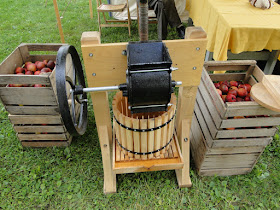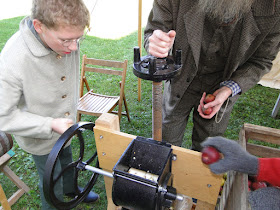And yet, I've not seen any reenactors present this all-so-important season - - except my Civil War group, the 21st Michigan.
 |
| Apparitions of the past become the present... |
And I then asked myself, "Why hadn't I acted upon it before now?" I mean, I actually had spoken a bit about the harvest at previous Wolcott events, and I would ask modern visitors how their crop fared and how their canning and drying was coming along.
But I only touched upon the subject...just to get my feet wet.
No matter the reasons why celebrating the harvest hadn't been done before, it was during 2013's Wolcott event when I finally decided to do something about showing this so important time of year, for I felt the time was right, and I grabbed the bull by the horns and forged ahead throughout the following year to make it happen. Delving into research, visiting historic Greenfield Village for their fall harvest weekends, and simply immersing myself in the season, I soon realized that we could create the ultimate autumn experience at our reenactment, more than visiting a cider mill even. And the civilian portion of the Civil War group I belong to - the 21st Michigan - did, in 2014, and has been actively presenting the fall harvest ever since.
Now, with the Wolcott Mill reenactment no longer happening, we changed locations. We moved to, of all places, smack-dab in the middle of Downtown Detroit.
Yes, that Downtown Detroit, at historic Fort Wayne, an actual fort built in the 1840s, from which men dating back to the Civil War through Vietnam were sent off to war.
 | ||
Detroit's Historic Fort Wayne celebrates the harvest.
|
So, let's journey back to a time when people lived exclusively by the seasons. To a time where labor meant a bit more than working 9 to 5. To a time when there was no sick days, vacation days, or unemployment wages...
 |
| Here is our little "harvest camp" - four tents aren't nearly enough to accurately show all that took place on the home front in October of 1863, but we certainly gave our visitors a fair idea. |
 |
| But it took manpower, womanpower, and childpower to make enough candles to last for the year. My display shows how many dips it takes to make a good burning beeswax candle. |
 |
| Cutting the cabbage for sauerkraut. The name itself means "sour herb or cabbage." |
But we were not the only game in town!
 |
| Our next door neighbors, who are actually from Ohio, were cooking up a storm. |
 |
| And part of their contribution to our thresherman's dinner was corn, to be shelled by hand right off the cob. |
 |
| A group of youngsters known as the "Young Marines" (described to me as Boy Scouts on steroids) helped out in the shelling of the corn. |
 |
| ...applesauce! |
 |
| Mrs. Woodruff spent a good part of her day preparing it, from peeling the apples to chopping them to putting them in the pot to be cooked. |
 |
| The big round pot on the left, that's where the applesauce was! |
 |
| Every-so-often Mrs. Woodruff would give the apples a stir. |
 |
| Noodles were also made by hand. |
 |
| The chicken coup tent. |
 |
| So what do we have over at the Cary tent? |
 |
| An old-fashioned cider press! And loads of apples! |
 |
| The reenacting kids always enjoy turning the crank to the grinder... |
 |
| ...which mulches up the apples... |
 |
| ...and sends them to the bucket below. |
 |
| And then the screw is turned to press the shredded apples until all of the juice is squeezed out. |
 |
| As the kids turn the screw, you can see the apple cider dripping out onto the pan below. |
 |
| The pan is tilted slightly so the cider can drip into the pan. |
 |
| Of which is then poured into jars. With all of the apples used, we always have plenty of cider for everyone who takes part. |
 |
| And then we had our neighbors to the opposite end: the Goodens. |
 |
| Mrs. Gooden made a wonderful pumpkin pie!! |
 |
| Z.D. Attie made applehead dolls. |
 |
| THIS is an applehead doll. |
 |
| And the more the apple ages, the more the face becomes an old crony! Very cool. |
 |
| Cooking over an open fire is not very different from open-hearth cooking, and the talent folks who cook this way have always amazes me. |
Normally we have this meal in the late afternoon or early evening, just about sunset into twilight time. With the room lit by candles, the ambiance is an immersion experience like little else.
This year, however, we changed it up a bit and had it on Sunday afternoon to accommodate a few people who said they wouldn't be able to make it on Saturday evening.
Even on this bright and sunny Sunday, they still didn't show up.
So next year it'll be back to the Saturday evening as it should be.
But, we still had a grand time!
 |
| The Goodens and their friends. |
 |
| I see two Jennifers, three generations from one family, and an amazing wet plate photographer in this picture. Oh, and some good food, too. |
 |
| Here we have the Woodruff family and Mrs. Attie enjoying the harvest meal. |
 |
| Here's my table (though I'm taking the picture) with my two sons, the Kushners, and someone who is really happy about eating! |
 |
| Ah...there it is: Do you see the applesauce? How about the shelled corn? Beans, potatoes, and corn beef. Yeah...we know how to throw a harvest dinner! |
 |
| And afterward we had games such as cribbage. |
 |
| There were also a couple of fiddlers playing period tunes. |
 |
| Some of the ladies did the spinning dance. Never heard of it? Then you need to hang around them! |
 |
| My son Robbie is not nearly as dejected as he looks here. In fact, he was quite happy - how often does one get to sleep inside a fort built in the 1840s? |
 |
| Sweet little Tabitha. She is the first grandchild for 21st Michigan president Jim Cary and his wife Candy. This was Tabitha's first reenactment! |
 |
| Ian & Carrie: Carrie is due with their first child in November. Ian smokes a pipe. Carrie does not seem too pleased. |
Now we'll get into some fun poses we sneak in when the visitors are not around:
 |
| It was 'dress your chicken up as a witch' day. Not really, but Mary Anne definitely dressed her chick up as a witch! |
 |
| Larissa loves her coffee...especially on a cold fall morning. |
 |
| My son, Robbie, also loves his coffee. I'm not sure who loves their coffee more! |
 |
| Jumping into the future, Larissaa saw herself and her true love in a movie poster. |
 |
| Jim learned not to fall asleep at the table with Larissa around. Or when Ken has his camera. |
 |
| "I have a pipe, therefore I am right." Jennifer wins all the arguments when she has her pipe. |
 |
| Big city turn me loose and set me free~ Yeah...I'm a suburbanite with a touch of country boy, but I do enjoy seeing the skyscrapers looming up seemingly out of nowhere every once in a while. |
 |
| You see that street sign, Bagley Street? That's the street that Henry Ford once lived on. No big deal, right? Except that when he was living on this street back in 1896 - not far at all from this corner...only about a mile or so - he built his first car, the Quadricycle, in the shed behind his house. Detroit needs to celebrate this street more. Unfortunately, his house and shed at 58 Bagley Avenue is long gone, replaced by the Michigan Theater which is now a parking garage. |
Having the opportunity, no matter how small, to take part in a historical harvest is something I look forward to every year. When I dress in my period clothing and take part in a living history harvest reenactment, I'm there, in the past, with the spirit of the farmers within me. I only hope I do them the honor they deserve.
As I have said many, many times before, reenacting a battle is only a part of the picture. And it's those of us in the civilian contingencies who complete it...make it whole. And doing something like what you see here helps to add life to the past for visitors and for the reenactors themselves.
Next year I am hoping to expand on it even more...
The spirit of harvest past indeed.
Until next time, see you in time.
To read (and see) a more in-depth posting on the fall harvest of both Victorian and Colonial times, please click HERE
To read about a year in the life on a colonial farm, please click HERE
~ ~ ~








No comments:
Post a Comment